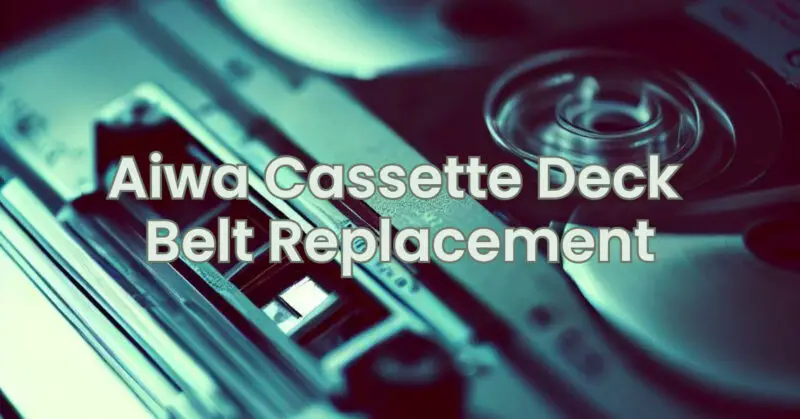The Aiwa cassette deck has long been a beloved device for music enthusiasts, offering high-quality audio playback. Over time, the drive belts in the cassette deck may become stretched, worn out, or damaged, affecting the overall performance. If you’re experiencing issues with the cassette deck, such as slow playback, no playback, or a wobbly cassette mechanism, it may be time to replace the drive belts. In this step-by-step guide, we will walk you through the process of Aiwa cassette deck belt replacement, allowing you to restore the functionality of your cherished audio device.
Note: Before proceeding with belt replacement, ensure you have the correct replacement belts for your specific Aiwa cassette deck model. Consult the user manual or contact Aiwa customer support for assistance in identifying the appropriate belts.
Step 1: Gather the Necessary Tools: To perform the Aiwa cassette deck belt replacement, you will need the following tools:
- Replacement belts (specific to your Aiwa cassette deck model)
- Screwdriver (typically Phillips or flathead, depending on the deck)
- Tweezers or needle-nose pliers (for handling small parts)
- Isopropyl alcohol and cotton swabs (for cleaning, if necessary)
Step 2: Prepare the Workspace: Find a well-lit, clean, and spacious workspace to perform the belt replacement. Ensure you have enough room to lay out the cassette deck components and keep track of small parts during the process.
Step 3: Power Off and Disconnect: Before starting any maintenance or repair work, always power off and unplug the Aiwa cassette deck from the electrical outlet to avoid any risk of electric shock.
Step 4: Open the Cassette Deck: Using the appropriate screwdriver, carefully remove the screws securing the top cover of the cassette deck. Set the screws aside in a safe place. Gently lift and remove the cover, exposing the internal components of the cassette deck.
Step 5: Locate the Drive Belts: Once the internal components are visible, locate the drive belts. They are typically made of rubber and are responsible for moving the cassette mechanism. In most cases, there are two belts: one for the capstan motor and one for the flywheel.
Step 6: Remove the Old Belts: Using tweezers or needle-nose pliers, carefully lift and remove the old belts from their positions. Take note of the belt routing and placement before removing them completely. If the belts have deteriorated or broken, remove any remaining pieces and clean any residue from the pulleys and gears using isopropyl alcohol and cotton swabs.
Step 7: Install the New Belts: Take the replacement belts that match your Aiwa cassette deck model. Starting with the capstan motor belt, position it around the pulleys and gears according to the observed routing from the old belt. Ensure it fits snugly and is properly seated on all necessary components. Repeat the process for the flywheel belt.
Step 8: Reassemble the Cassette Deck: Carefully reattach the top cover of the cassette deck, aligning it with the screw holes. Insert and tighten the screws using the screwdriver, but avoid over-tightening to prevent damage to the cassette deck’s housing.
Step 9: Test and Adjust: After reassembling the cassette deck, reconnect it to the power source and power it on. Test the playback, fast-forward, and rewind functions to ensure the new belts are functioning correctly. If you notice any issues or irregularities, double-check the belt placement and make any necessary adjustments.
Conclusion: Replacing the drive belts in your Aiwa cassette deck can be a rewarding DIY project, bringing new life to your cherished audio device. By following this step-by-step guide, you can successfully replace the belts and restore the functionality of your cassette deck. Remember to gather the necessary tools, prepare a suitable workspace, power off and disconnect the deck, open the cassette deck, locate and remove the old belts, install the new belts carefully, reassemble the deck, and finally, test and adjust as needed. With some patience and attention to detail, you can enjoy smooth and reliable playback from your Aiwa cassette deck once again.

